Related Research Articles
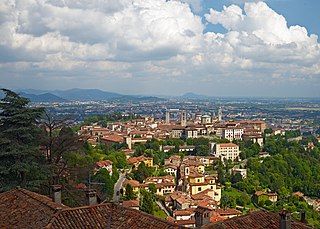
Bergamo is a city in the alpine Lombardy region of northern Italy, approximately 40 km (25 mi) northeast of Milan, and about 30 km (19 mi) from the alpine lakes Como and Iseo and 70 km (43 mi) from Garda and Maggiore. The Bergamo Alps begin immediately north of the city.

Capriate San Gervasio is a town and comune in the province of Bergamo, in Lombardy, northern Italy. As of 2019, its population was 8,216.

Caravaggio is a town and comune in the province of Bergamo, in Lombardy, Italy, 40 kilometres (25 mi) east of Milan. It is the home town of renaissance era artists Caravaggio and Polidoro da Caravaggio.

Albino is a comune in the province of Bergamo, in Lombardy, northern Italy. It is located northeast of Bergamo and is situated in the valley of the river Serio. The comune is included in the perimeter of the Alpine Convention international treaty.
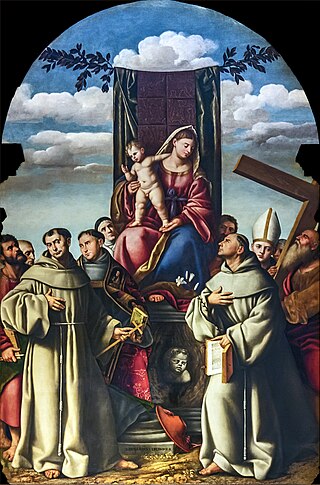
Bernardino Licinio was an Italian High Renaissance painter of Venice and Lombardy. He mainly painted portraits and religious canvases.
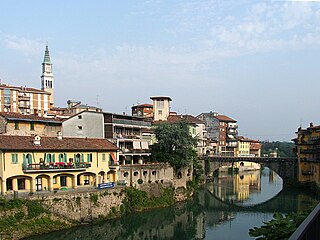
Ponte San Pietro is a comune in the province of Bergamo, Lombardy, northern Italy. It is about 40 kilometres (25 mi) northeast of Milan and about 7 kilometres (4 mi) west of Bergamo.

Saint Proculus was a bishop of Verona who survived the persecutions of Diocletian. He died of natural causes at Verona. He is commemorated on December 9.

Cologno al Serio is a comune (municipality) in the Province of Bergamo in the Italian region of Lombardy, located about 45 kilometres (28 mi) northeast of Milan and about 10 kilometres (6 mi) south of Bergamo.

Gromo is a comune (municipality) in the Province of Bergamo in the Italian region of Lombardy, located about 80 kilometres (50 mi) northeast of Milan and about 35 kilometres (22 mi) northeast of Bergamo. As of 31 December 2004, it had a population of 1,246 and an area of 20.0 square kilometres (7.7 sq mi).

Presezzo is a comune (municipality) in the Province of Bergamo in the Italian region of Lombardy, located about 40 kilometres (25 mi) northeast of Milan and about 8 kilometres (5 mi) west of Bergamo. As of 31 December 2004, it had a population of 4,657 and an area of 2.1 square kilometres (0.81 sq mi).

Romano di Lombardia is a comune (municipality) in the Province of Bergamo in the northern Italian region of Lombardy, located about 45 kilometres (28 mi) east of Milan and about 20 kilometres (12 mi) southeast of Bergamo. It received the honorary title of city with a presidential decree on September 17, 1962.

Spirano is a comune (municipality) in the Province of Bergamo in the Italian region of Lombardy, located about 40 kilometres (25 mi) northeast of Milan and about 13 kilometres (8 mi) south of Bergamo.
Suisio is a municipality in the Italian region of Lombardy, located about 35 kilometres (22 mi) northeast of Milan and about 20 (12 mi) kilometers west of Bergamo. It had a population of 3 794 inhabitants and an area of 4.6 square kilometres (1.8 sq mi).
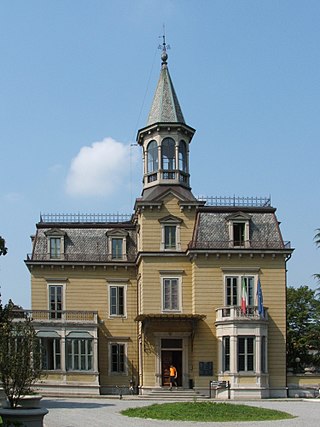
Zanica is a comune (municipality) of around 8,804 inhabitants in the Province of Bergamo in the Italian region of Lombardy, located about 45 kilometres (28 mi) northeast of Milan and 7 kilometres (4 mi) south of Bergamo. Zanica borders the following municipalities: Azzano San Paolo, Cavernago, Comun Nuovo, Grassobbio, Orio al Serio, Stezzano, Urgnano.

The Diocese of Bergamo is a Latin diocese of the Catholic Church in Italy, and is a suffragan of the Archdiocese of Milan. Geographically, Bergamo stood between the mainland interests of the Republic of Venice, and the territory of the Duchy of Milan. The duchy was regularly contested by the French and the Holy Roman Empire, which brought about repeated military operations. Internally, from the 12th to the 15th century, there was the usual party strife between the Guelphs, who generally supported the political and religious policies of the Papacy; and the Ghibellines, who generally supported the Emperors. As Kings of Italy, the emperors were feudal overlords of Lombardy.

Alexander of Bergamo is the patron saint of Bergamo, as well as Capriate San Gervasio and Cervignano d'Adda. Alexander may have been a Roman soldier or resident of Bergamo who was tortured and killed for not renouncing his Christian faith. Details of his life are uncertain, but subsequent Christian stories consider him a centurion of the Theban Legion commanded by Maurice.
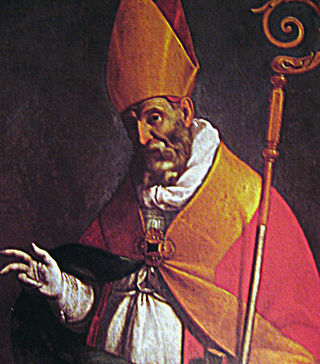
Saint Narnus is venerated as the first bishop of Bergamo. Christian tradition holds that he was consecrated during the Apostolic Age in his office by St. Barnabas, although Narnus probably lived later than that. The oldest source that mentions Narnus dates from the 13th century; it was written by Branca da Gandino, a friar. He considers Narnus a bishop of Bergamo during the reign of Diocletian in the fourth century.
Saint Viator may refer to:

Protasius was Archbishop of Milan. He is honored as a saint in the Catholic Church, with his feast day celebrated on 24 November, the day of his death.
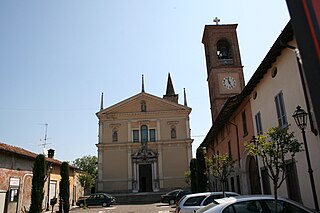
San Michele Arcangelo is a renaissance-style, Roman Catholic parish church located in the town of Antegnate, province of Bergamo, region of Lombardy, Italy.